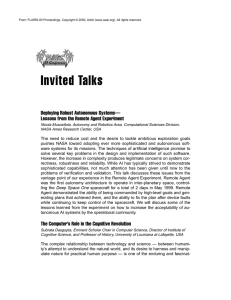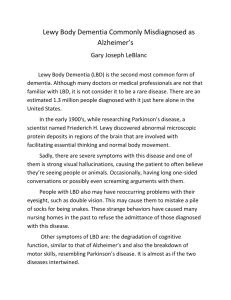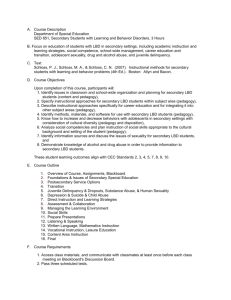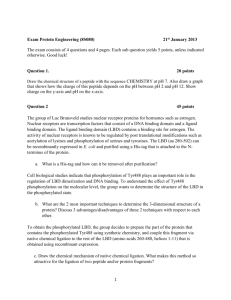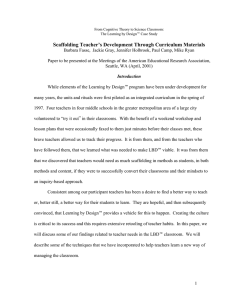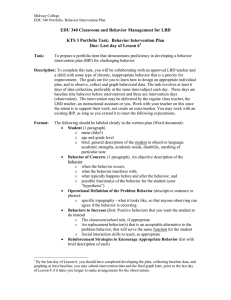Learning by Design™: Promoting Deep Science Learning Through A Design Approach
advertisement
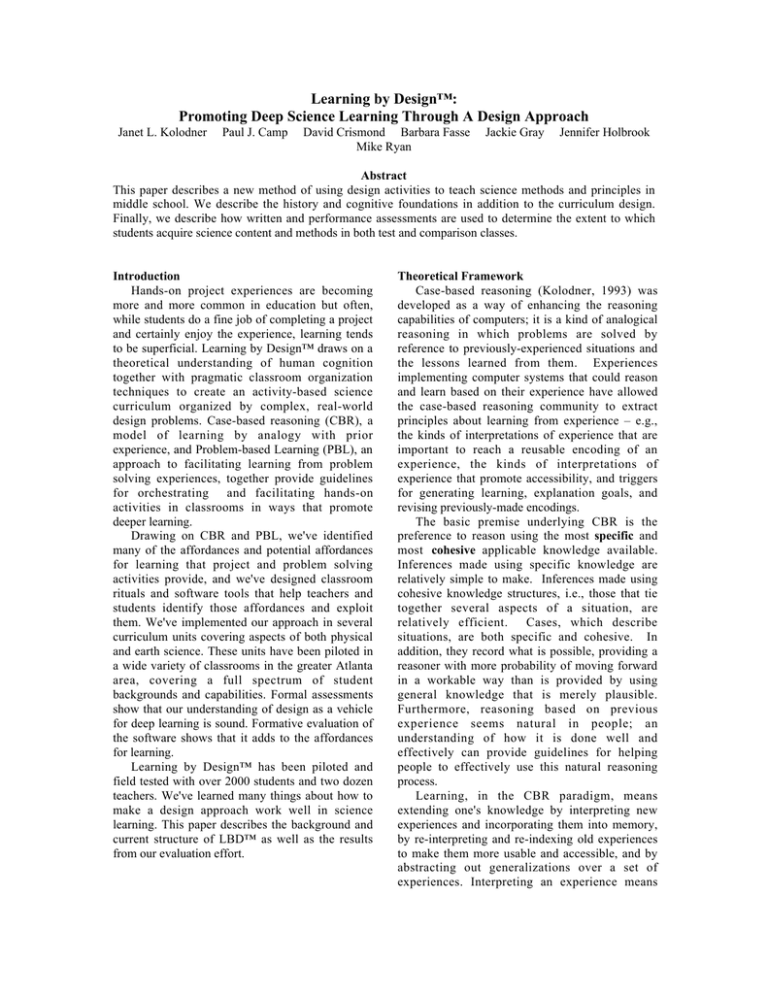
Learning by Design™: Promoting Deep Science Learning Through A Design Approach Janet L. Kolodner Paul J. Camp David Crismond Barbara Fasse Mike Ryan Jackie Gray Jennifer Holbrook Abstract This paper describes a new method of using design activities to teach science methods and principles in middle school. We describe the history and cognitive foundations in addition to the curriculum design. Finally, we describe how written and performance assessments are used to determine the extent to which students acquire science content and methods in both test and comparison classes. Introduction Hands-on project experiences are becoming more and more common in education but often, while students do a fine job of completing a project and certainly enjoy the experience, learning tends to be superficial. Learning by Design™ draws on a theoretical understanding of human cognition together with pragmatic classroom organization techniques to create an activity-based science curriculum organized by complex, real-world design problems. Case-based reasoning (CBR), a model of learning by analogy with prior experience, and Problem-based Learning (PBL), an approach to facilitating learning from problem solving experiences, together provide guidelines for orchestrating and facilitating hands-on activities in classrooms in ways that promote deeper learning. Drawing on CBR and PBL, we've identified many of the affordances and potential affordances for learning that project and problem solving activities provide, and we've designed classroom rituals and software tools that help teachers and students identify those affordances and exploit them. We've implemented our approach in several curriculum units covering aspects of both physical and earth science. These units have been piloted in a wide variety of classrooms in the greater Atlanta area, covering a full spectrum of student backgrounds and capabilities. Formal assessments show that our understanding of design as a vehicle for deep learning is sound. Formative evaluation of the software shows that it adds to the affordances for learning. Learning by Design™ has been piloted and field tested with over 2000 students and two dozen teachers. We've learned many things about how to make a design approach work well in science learning. This paper describes the background and current structure of LBD™ as well as the results from our evaluation effort. Theoretical Framework Case-based reasoning (Kolodner, 1993) was developed as a way of enhancing the reasoning capabilities of computers; it is a kind of analogical reasoning in which problems are solved by reference to previously-experienced situations and the lessons learned from them. Experiences implementing computer systems that could reason and learn based on their experience have allowed the case-based reasoning community to extract principles about learning from experience – e.g., the kinds of interpretations of experience that are important to reach a reusable encoding of an experience, the kinds of interpretations of experience that promote accessibility, and triggers for generating learning, explanation goals, and revising previously-made encodings. The basic premise underlying CBR is the preference to reason using the most specific and most cohesive applicable knowledge available. Inferences made using specific knowledge are relatively simple to make. Inferences made using cohesive knowledge structures, i.e., those that tie together several aspects of a situation, are relatively efficient. Cases, which describe situations, are both specific and cohesive. In addition, they record what is possible, providing a reasoner with more probability of moving forward in a workable way than is provided by using general knowledge that is merely plausible. Furthermore, reasoning based on previous experience seems natural in people; an understanding of how it is done well and effectively can provide guidelines for helping people to effectively use this natural reasoning process. Learning, in the CBR paradigm, means extending one's knowledge by interpreting new experiences and incorporating them into memory, by re-interpreting and re-indexing old experiences to make them more usable and accessible, and by abstracting out generalizations over a set of experiences. Interpreting an experience means creating an explanation that connects one’s goals and actions with resulting outcomes. Such learning depends heavily on the reasoner’s ability to create such explanations, suggesting that the ability and desire to explain are key to promoting learning. CBR thus gives failure a central role in promoting learning because failure promotes a need to explain. When the reasoner's expectations fail, it is alerted that its knowledge or reasoning is deficient. When some outcome or solution is unsuccessful, the reasoner is similarly alerted of a deficiency in his/her knowledge. When such failures happen in the context of attempting to achieve a personally-meaningful goal, the reasoner wants to explain so that he/she can be more successful. Crucial to recognizing and interpreting failure is useful feedback from the world. A reasoner that is connected to the world will be able to evaluate its solutions with respect to what results from them, allowing indexing that discriminates usability of old cases and allowing good judgments later about reuse. Problem-based learning (Barrows, 1985) is an approach to educational practice that has students learn by solving authentic, real-world problems and reflecting on their experiences. Because the problems are complex, students work in groups, where they pool their expertise and experience and together grapple with the complexities of the issues that must be considered. Coaches guide student reflection on their problem-solving experiences, asking students to articulate both the concepts and skills they are learning, and helping them identify the cognitive skills needed for problem solving, the full range of skills needed for collaboration and articulation, and the principles behind those skills. But students decide how to go about solving problems and what they need to learn, while coaches question students to force them to justify their approach and explain their conclusions. Students learn the practices of the profession they are learning, the content professionals need to know, as well as skills needed for life-long learning. PBL has been used substantially at medical and business schools for over 20 years. Research shows that students in problem-based curricula are indeed learning facts and concepts and the skills needed for critical problem solving and self-learning. Problem-based learning prescribes a highlystructured sequence of classroom practices. Students keep track, on a set of whiteboards, of facts they know, hypotheses and ideas they have about explaining and solving the problem, and issues they do not yet understand and need to learn more about (learning issues). The whiteboards organize and track the progress of an investigative cycle that continues until students are satisfied that they have solved the problem. The explanations from those discussions which soon fill up the whiteboards with ideas, diagrams, and explanations. This in-process reflection helps students make connections between their problemsolving goals, the processes involved in achieving those goals, and the content they are learning. While CBR suggests many of the kinds of experiences students should have to learn deeply, PBL suggests means of coaching and scaffolding those experiences so that they are both studentcentered and focused on relevant content and skills. Both suggest that students’ experiences should be well-orchestrated so that early experiences help students identify what they need to learn, and later experiences engage students in investigations that allow such learning. CBR suggests, in addition, that later experiences be rich in application and feedback, iteratively looping through that cycle until students’ understandings are complete or adequate. PBL suggests ways to intersperse reflection liberally with student activities, and CBR suggests that reflection be aimed in particular ways: at recalling previous experiences and examples that might be useful in solving the new problem, at extracting lessons learned from the current experience, and at anticipating contexts of usefulness for what is being learned from their activities. CBR, together with other cognitive theories, suggests that students should experience concepts and skills they are learning in a large enough variety of circumstances that they are able to learn the subtleties and richness of those concepts and skills (see, e.g., Bransford et al, 1999). Like constructionism (e.g., Kafai & Resnick, 1996), CBR suggests the importance of audience and sharing of experiences, but based on a cognitive need – the need to experience concepts and skills across multiple contexts. The two approaches complement each other well, and together, we believed, they could provide a powerful foundation for educational practice in the constructivist tradition, one that at once combined lessons learned from classroom practice with sound cognitive theory. In Learning by Design™, middle-school students learn science in the context of attempting to achieve design challenges. Students identify what they need to learn, engage in investigative activities to learn those things they’ve identified, and apply what they are learning to achieve their design goal. Significant attention is given to several activities as they are engaging in the design challenge: reflection on and articulation of the practices being engaged in (both before and after engaging in the practices), sharing experiences with each other, justifying ideas with evidence, explaining results, and iteration towards successful solutions. In iteratively refining their designs, students have a chance to debug their conceptions and identify holes in what they know. Using the practices of problem-based learning (PBL), the teacher helps students reflect on their experiences in such a way that they extract, articulate and keep track of both the content and the skills they are learning. Using guidelines from case-based reasoning, teachers are taught to aim reflective discussions and other activities towards helping students to turn their experiences into cases -stored in their memories in ways that allow them to remember and apply them in later situations. Research shows that students participating in these kinds of learning activities are more motivated to learn, that what they learn is more usable than the knowledge learned by students carrying out rote activities, and that they tend to better learn higher order thinking skills than do students in other learning situations (Hmelo, 1995). LBD™ is not unlike other cognitive-sciencederived approaches to science education. Like constructionism (Papert, 1991), it emphasizes iterative design and construction of personallymeaningful artifacts. But the particular cognitive theories we’ve used in designing LBD™ provide us with precise reasons why this approach should work and guidelines on how to orchestrate the activity of a typical middle-school classroom. Like project-based learning (Blumenfeld et al., 1991), it focuses on learning inquiry skills in the context of solving real-world problems. But, in addition, the cognitive theories we’ve used in designing LBD™ focus on the importance of applying what one has learned in ways that provide timely and interpretable feedback to motivate and afford refinement of conceptions. Like cognitive apprenticeship (Collins et al., 1989), it integrates learning of content with learning of practices, and puts the teacher in the role of coach and articulator of process, gradually having students take over those roles. But LBD™ uses the design challenge to structure these activities, and as a device to help students identify for themselves what they need to learn. Like goal-based scenarios (Schank et al., 1994), it puts learners in the position of taking on a meaningful challenge and provides them with the learning experiences they need to be successful, but through powerful use of collaboration, it helps learners to experience far more variation in the application and use of concepts and skills than a single person working through a challenge could experience. LBD™ curricula currently exist in two areas of science, physics and geology. The physics curriculum is the older and more highly refined of the two. Both, however, begin with a launcher unit to establish the culture of the classroom. By this we mean both the techniques of investigation and reflection as well as the mechanics of smooth group interactions. The physical science launcher revolves around the movie Apollo 13 which illustrates iterative design practice in an engaging way. It involves several small design challenges, such as building a book support out of index cards, in which the science is reasonably straightforward. This keeps the science mostly out of the way while students gain experience with experimental investigations, presentations, group work and learning from design. It is capped off with a more complex parachute design activity to integrate all these new techniques and solve a single multifaceted design challenge. The geology launcher unit, Digging In, follows much the same format, capped off with an erosion management challenge. It draws more heavily on analysis of written expert case histories than does Apollo 13 since that will be a central learning method in subsequent geology units. To support this, we have developed tools to scaffold students in extracting Figure 1 A Design Diary page to scaffold critical interpretation of an expert case. important lessons and, more importantly, questions regarding what they need to know from the case histories (Figure 1). It also introduces the scientific use of models, and students learn from experience the rules for crafting models that will produce useful and accurate observations, reflective of a problem that they cannot handle directly due to its size (e.g. attention to scale, both in dimensions and processes, and reliability of results). Each launcher unit is then followed by a much more involved and extended design challenge. For physical science, students are challenged to design a powered vehicle that will be able to traverse a specified test track. Along the way, they learn the basics of kinematics and Newton's laws of motion, and use that knowledge to inform and revise their designs. For geology, the big challenge is to assess the problems involved in construction of a series of tunnels for a train across Georgia and recommend methods for dealing with those problems. Students learn the scientific principles underlying physical properties of rocks, the rock cycle, groundwater movement and the basics of faults and folds. Since most of these are areas that are not directly accessible in the classroom due to issues of time, space, economics or safety, students learn much of the underlying science through designing and constructing carefully scaled models as well as reading case histories of real world tunnel design and construction. Figure 2 The cycle of activities in an LBD™ classroom. This cycle will be traversed many times to iteratively solve a design challenge The physical science units are now in their fourth iteration whereas the earth science units are being piloted this year. Also in the piloting stage are some less well developed units or pieces of units on simple machines, work and energy, and beach erosion. In the typical sequence of activities in a Learning-by-Design™ unit, summarized by the LBD™ cycle, students begin by encountering a design challenge that they are asked to achieve. To help them understand the ins and outs of the challenge, we help them to explore the materials and/or environment in which the challenge must be achieved by “messing about” with construction materials or with objects in the challenge environment to see what their constraints and affordances are and to get some idea of the issues they will need to address. Following this are cycles of exploratory and experimental work, each followed by reflection on what has been learned, focusing in each cycle, first, on learning enough about some relevant “learning issue” and then on applying what has been learned. Potential solutions to the design challenge are attempted in each cycle and evaluated by building and testing a model or actual device; comparing different design alternatives based on qualitative and/or quantitative understandings; or analyzing using established design guidelines or the ratings of experts. Presentations and discussions following each cycle focus on what’s been tried, what’s been learned, how to apply what’s been learned, explaining things that didn’t work as well as expected, and identifying what else still needs to be learned. Within this framework are myriad opportunities for students to share their work with others and hear their feedback and ideas. Presentations are in the form of “pin-up sessions” and "gallery walks," (Kolodner et al., 1998) where students present their design plans or what they’ve attempted and what happened as a result. Generally speaking, pin-up sessions precede design activities and describe what students intend to do. Gallery walks follow design testing, usually contain the finished artifact, and describe the consequences of design decisions, frequently through performance. In their presentations, we ask students to focus on the design decisions they’ve made, explaining how they think their designs work, and justifying those design decisions and their explanations using science and engineering concepts and vocabulary and the evidence that comes from the investigations they and their classmates have carried out. Data Sources We’ve collected data in a number of different ways. First, we’ve tested students on physical science content knowledge and general science skill knowledge using a standardized written test format. It was administered in a pre-/postimplementation design in LBD™ classrooms and comparison classrooms. Items on the test were drawn from a number of normed and tested sources, including the National Assessment of Educational Progress (NAEP), released items from the Third International Mathematics and Science Study (TIMSS), the Force Concept Inventory and the Force and Motion Conceptual Evaluation, as well as items of our own. We have designed the test items so that, by cross referencing subsets of the questions, we can pinpoint the conceptual model used by the students and see how it has evolved. We’ve also been testing students in both LBD™ and comparison classrooms for changes in content knowledge, science skills, and the ability of students to solve problems in group settings using two performance-based assessment tasks, both adapted from the PALS database (SRI, 1999) with the addition of an initial design activity on each assessment. These assessments were extensively videotaped. We have developed a tool for analyzing the tapes for both collaboration issues and use of appropriate scientific knowledge to solve the challenge (Gray, Camp and Holbrook, 2001). We’ve also conducted extensive observations in classrooms (Fasse & Kolodner, 2000). A full-time ethnographer traveled the circuit of classrooms observing each once per week for each of the field tests. More recently, we have focussed on intensive observation of a few selected LBD™ and comparison classrooms. Field notes from these regular classroom observations were combined with both formal and informal interviews to inform a comprehensive documentation of practices at the student, teacher, group, and whole-class levels. Since performance assessments are perhaps less familiar than written tests, it is worth describing in some additional detail how they are constructed and used. A typical task is called "Speeding in a School Zone." The situation presented to students in that there is an alleged problem with speeders in front of their school, endangering the students. Their job is to devise a way to measure the speed of the cars and determine if a problem does exist. Figure 3: Several example items from the video coding rubric. Distributed efforts and tasks Not at all at least one of the members of the group suggests that others help do the task 1 at least two of the members of the group suggest that all do some part of the task 2 3 at least one of the members of the group suggests and leads the group in dividing and doing the task 4 More than one of the members of the group enlists the participation of all the team in doing the task 5 Students show evidence of using prior knowledge to solve the problem Not at all at least half of the team mentions a prior event or concept that relates to the problem Several events and concepts are mentioned and applied to the problem 3 4 at least one of the members of the group suggest a method to test at least one variable at least one of the members suggest a method and indicates an understanding of fair testing at least one of the members suggest a method and indicates an understanding of fair testing and controlling for variables 2 3 4 at least one of the members of the group mentions a prior event or concept that relates to the problem 1 2 The group routinely recalls events or concepts that assist in their collaborative problem solving 5 Students use science practice to decide on method/procedures Not at all 1 Most of the team agrees that the method used will fairly test the important variables and their decisions would actually be a reasonable experiment 5 Answers to the questions are negotiated based on data Not at all at least one of the members of the group refers back to the data 1 2 at least one of the members of the group refers back to the data and the group uses the data 3 at least two of the members of the group refer back to the data and the group uses the data accurately to respond 4 Most of the group recognizes the need to look back at the data and discusses the data to reach an answer that is appropriate 5 To assist them in testing the method, they will be given a battery powered toy car, a tape measure and a stopwatch. Initially, these items are shown to them but they are not allowed to have them yet. They are also told that they can use any other items they deem necessary. The first section of the assessment asks for them to design their own experiment and write out a description of it, including an explanation of how it answers the question. In this section, we assess what scientific and methodological factors they believe are important considerations. They typically have 10- control for this, in another period we will perform a group consult. In this procedure, students are allowed to discuss the tasks as a group, but each student is required to write down their own answers in their own words. Finally, since many classes do not do group work, and since we are also interested in the level of individual understanding that different classroom techniques afford, we have a third period in which group work is only allowed during the middle, experimental, section. In the initial design and final interpretation sections students must decide on their own answers and Figure 4 Means and standard deviations for categories from performance assessment video coding for LBD students (typical and honors) and Comparison students (typical and honors) Coding category Means (SD) LBD Typical Means (SD) Comparison Typical Means (SD) Honors Negotiations Distributed Effort/tasks Prior knowledge Prior Knowledge adequate Science terms used Science practice skills 2.50 (1.00) 3.25 (.50) * 1.50 (.58) 2.25 (.50) 4.50 (.58) *** 4.00 (1.15) Means (SD) Honors Comparison 2.67 (.58) 3.00 (1.00) 2.25 (.50) 2.75 (.96) `1.75 (.50) 1.50 (.58) 3.75 (1.50) 3.50 (1.00) 3.0 (.00) 2.67 (1.15) 2.50 (1.29) 2.75 (.96) 1.75 (.50) 2.25 (.50) 3.50 (1.00) 4.75 (.50) *** 2.67 (1.15) 2.67 (.71) Self-checks 3.00 (.82) ** 1.50 (.58) 4.25 (.50) *** 2.33 (.58) Significance levels: * = p < .03; ** = p < .02; *** = p < .01 The means are based on the likert scale: 1 - 5 15 minutes to perform this task. Then, all the equipment is passed out to each group and they are given a previously designed experiment to accomplish the same task (i.e. a typical velocity measurement lab). In the final section, students are asked to answer a series of interpretational questions using the data collected in the experiment. Our method of administering the performance assessments has evolved over time as we have watched students carry them out. Currently, we test several class periods of the same teacher at the same school to control for social and academic factors. We do a different testing method in each period. In one class, we will tell them to work as a group, deciding collectively on the correct answers and producing a single agreed-upon document to hand in at the end. We observed that frequently the hand that holds the pen wields the power – other kids' attention wanders in and out, and often the scribe will write down whatever they think is correct regardless of what the group says. To write them down without group discussion. In addition to collecting the written documents, we videotape the group and group consult classes for post-analysis (Figure 3). We do not videotape the individual classes since there is no interesting discussion going on so taping would be pointless. Results We have not yet completed a full analysis of the data, but several trends are showing up (Hickey, internal report). First, comparing our most talented classes with similar classes learning in a more traditional inquiry style, and where teachers in both situations are equally talented, we find that performance on written tests is pretty much equal. We find, however, that those in the LBD™ classes listen to each other better, communicate ideas better, and are more planful in their approach on the group performance task. Second, and more interesting, is the trend we are seeing when comparing all LBD™ students to the comparison classes. On scaled pre-/postcontent tests, LBD™ class’ gains seem to be significantly greater than those of comparison classes. When scaled with values from –2.0 to +2.0, the average LBD™ student score went from .647 to 1.27, while the comparison students’ average went from 1.28 to 1.47 (F(1,222) = 12.8, p < .001). LBD™ students, on the whole, gained far more from instruction than did non-LBD™ students. This is particularly gratifying because the comparison classes that followed through on submitting data measured high on all advantage factors. When we analyze the results from the various individual teachers, we find that the largest gains among our LBD™ students were in those classes that are the most socio-economically disadvantaged and who tested lowest on the pretest. Interestingly, these classes also had teachers with less background in physical science. Furthermore, our analysis of the videos of groups carrying out the performance-based assessment task shows that LBD™ students, even these lessadvantaged ones, are as capable or better at planning, listening, and communicating than even the most talented comparison students (Figure 4 for preliminary results). Third, we see a trend towards re-engaging girls in science. Preliminary scoring on our 1998-99 data shows that while girls score lower than boys, as a rule, on pre-tests, they are equal with boys or ahead of them on post-tests. Preliminary analysis of the video data is also beginning to show some interesting trends. Within comparable student populations, LBD™ students score higher on almost all categories of problemsolving & analysis. They are more sophisticated at science practice & managing a collaborative scientific investigation as well. Non-LBD™ students treat the task as one of simply writing something down, never really addressing it as a challenge needing distributed effort. All LBD™ students negotiate a solution and see the task as requiring an experimental design. In addition, some LBD™ students recognize the need to distribute efforts and plan a sophisticated experiment. For more information, contact: Dr. Paul J. Camp, College of Computing, Georgia Institute of Technology, Atlanta, Georgia, 30332; 404-3850159; pjcamp@cc.gatech.edu. References Kolodner, J.L. (1993). Case-Based Reasoning. San Mateo, CA: Morgan Kaufmann. Collins, A, J.S. Brown, & S. E. Newman (1989). Cognitive Apprenticeship: Teaching the crafts of reading, writing, and mathematics. In L. B. Resnick (Ed.), Knowing, Learning, and Instruction: Essays in Honor of Robert Glaser. Hillsdale, NJ: Erlbaum. Pp. 453 – 494. Barrows, H. S. (1985). How to design a problembased curriculum for the preclinical years. NY: Springer. Bransford, J. D., Brown, A.L. & Cocking, R. R. (Eds.) (1999). Learning and Transfer (Chap. 2). In How People Learn: Brain, Mind, Experience, and School. Washington, DC: National Academy Press. Hmelo, C. E. (1995). Problem-based learning: Development of knowledge and reasoning strategies. In Proceedings of the Seventeenth Annual Conference of the Cognitive Science Society. Mahway, NJ: Erlbaum. Pp. 404-408. Papert, S. (1991). Situating Constructionism. In I. Harel & S. Papert (Eds.), Constructionism. Norwood, NJ: Ablex. Pp. 1 – 11. Blumenfeld, P.C., E. Soloway, R.W. Marx, J.S. Krajcik, M. Guzdial, and A. Palincsar (1991). Motivating project-based learning: Sustaining the doing, supporting the learning. Educational Psychologist, 26(3 & 4). pp. 369398. Collins, A, J.S. Brown, & S. E. Newman (1989). Cognitive Apprenticeship: Teaching the crafts of reading, writing, and mathematics. In L. B. Resnick (Ed.), Knowing, Learning, and Instruction: Essays in Honor of Robert Glaser. Hillsdale, NJ: Erlbaum. Pp. 453 – 494. Schank, R. C., Fano, A., Bell, B., & Jona, M. (1994). The design of goal-based scenarios. Journal of the Learning Sciences, 3(4), 305346. Kolodner, J. L., David Crismond, Jackie Gray, Jennifer Holbrook, Sadhana Puntambekar (1998). Learning by Design from Theory to Practice. Proceedings of ICLS 98. Charlottesville, VA: AACE, pp. 16-22. SRI International, Center for Technology in Learning. (1999). Performance Assessment Links in Science Website. http://www.ctl.sri.com/pals. Fasse, B. B. & Kolodner, J. L. (2000). Evaluating Classroom Practices Using Qualitative Research Methods: Defining and Refining the Process. In Proceedings of the Fourth International Conference of the Learning Sciences. Ann Arbor, MI: U. of Michigan. Gray, J., Paul J. Camp and Jennifer Holbrooke (2001). Science talk as a way to assess student transfer and learning: Implications for formative assessment, in preparation.
